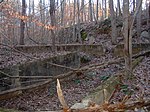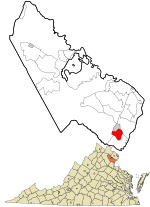Cabin Branch Pyrite Mine Historic District
Historic districts in Prince William County, VirginiaHistoric districts on the National Register of Historic Places in VirginiaIndustrial buildings and structures on the National Register of Historic Places in VirginiaNRHP infobox with nocatNational Register of Historic Places in Prince William County, Virginia ... and 4 more
Northern Virginia Registered Historic Place stubsPrince William County, Virginia geography stubsPrince William Forest ParkUse mdy dates from August 2023

Cabin Branch Pyrite Mine Historic District is a national historic district located at Prince William Forest Park, Triangle, Prince William County, Virginia. It encompasses 4 contributing sites and 42 contributing structures associated with the Cabin Branch pyrite mine. The pyrite mine opened in 1889, and remained in operation until 1919 or 1920. The property includes a number of capped mine shafts, and the remains of a commissary building and an old mill; and mine structures, including crusher house, mill, mechanical and support buildings, numerous rail lines.It was added to the National Register of Historic Places in 2002.
Excerpt from the Wikipedia article Cabin Branch Pyrite Mine Historic District (License: CC BY-SA 3.0, Authors, Images).Cabin Branch Pyrite Mine Historic District
North Valley Trail,
Geographical coordinates (GPS) Address Nearby Places Show on map
Geographical coordinates (GPS)
| Latitude | Longitude |
|---|---|
| N 38.576666666667 ° | E -77.350555555556 ° |
Address
North Valley Trail
North Valley Trail
22172
Virginia, United States
Open on Google Maps








